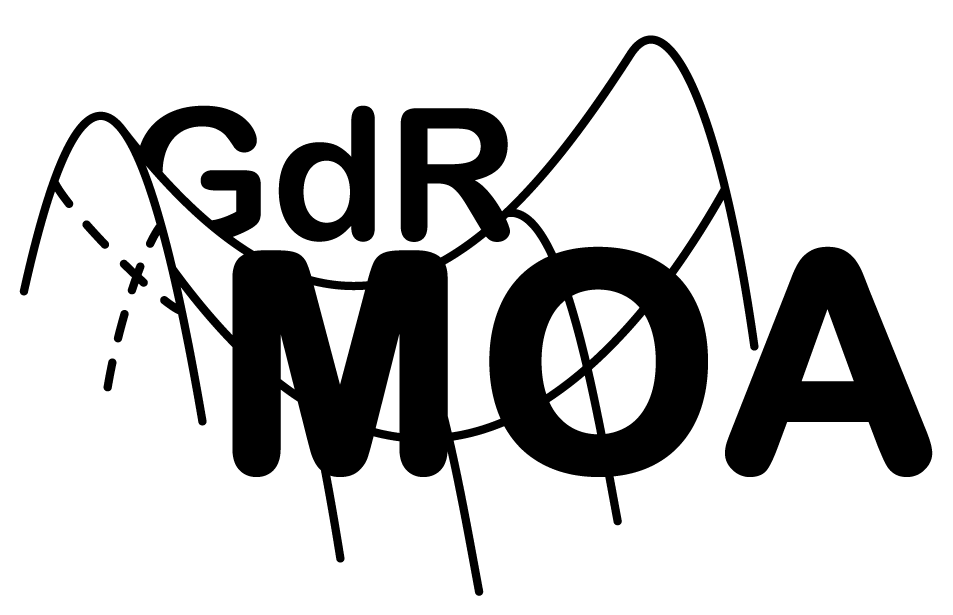| ||||||||||||||||||||||||||||||||||||||||||||
Journée scientifique SMAI-SIGMA 201118 novembre 2011, Université de Paris VI | ||||||||||||||||||||||||||||||||||||||||||||
|
Organisée par SMAI-SIGMA, groupe thématique de la Société de Mathématiques Appliquées et Industrielles (SMAI), cette rencontre annuelle a pour objectif de rassembler la communauté française autour des thémes Signal, Image, Géométrie Algorithmique, Modélisation Géométrique, et Approximation. Cette année, la journée a été préparée en collaboration avec les GDR MOA et MSPC ainsi que le laboratoire JLL. Parmi les sept exposés de niveau accessible pour non-experts, trois exposés de l'après-midi seront axés sur le sujet parcimonie en signal et image. ProgrammeLa journée comportera sept communications orales d'une durée de 40 minutes plus 5 minutes de discussion. Cliquer sur un titre pour voir le résumé de l'exposé.
InscriptionL'inscription est gratuite mais obligatoire. Veuillez remplir ce formulaire, la liste des participants sera mise à jour ultérieurement. Lieu de la rencontreLa Journée scientifique SMAI-SIGMA aura lieu à l'Université Pierre et Marie Curie - Paris VI, 4 Place Jussieu, 75005 Paris, Metro Jussieu. Plan d'accès pour l'université. Les exposés se déroulent le matin en salle 309, couloir 15-16, et l'après-midi en salle 326, couloir 15-25, toutes les deux au troisième étage. Les pauses se déroulent dans une salle café en face de la salle 309.
 Liste de participantsStephen Becker Laboratoire JLL, Paris VI Laurent Condat GREYC, Image team, Caen Rémi Gribonval INRIA Rennes Daniel Kressner ANCHP, EPF Lausanne Steve Oudot INRIA Saclay Nelly Pustelnik IMS, Bordeaux François-Xavier Vialard CEREMADE, Université Paris-Dauphine Marie-Laurence Mazure Laboratoire Jean Kuntzmann, Université Joseph Fourier, Grenoble Bang Cong Vu Laboratoire Jacques-Louis Lions, Paris 6 Frederic Nataf LJLL Jean-Marie Mirebeau Ceremade, Université Paris-Dauphine Patrice Brault LSS Laboratoire des Signaux et Systemes, CNRS UMR8506/ Supelec/ U-Psud Jerôme Bobin CEA Valérie Perrier Laboratoire Jean Kuntzmann, Grenoble INP Cécile Louchet Laboratoire MAPMO, Université d'Orléans Eric Nyiri Arts et Métiers ParisTech Yannick Kergosien LIM&BIO, Université Paris13 Frédéric Chazal INRIA Saclay Christian Gout LMI, INSA de Rouen Alexandre Bos INRIA Saclay Christophe Rabut Université de Toulouse (INSA, IMT, IREM) Anna Jezierska Université Paris-Est, Institut Gaspard Monge Emilie Chouzenoux LIGM, Université Paris Est Marne-La-Vallée Caroline Chaux LIGM UMR CNRS 8049 Ana Matos Université de Lille 1 Patrick Chenin Laboratoire LJK Université de Grenoble (UJF) Louie John VALLEJO Laboratoire Jacques-Louis Lions, Paris VI / Universite des Philippines Giap Nguyen Laboratoire L3i, Université de La Rochelle Laurent Duval IFP Energies nouvelles Andrés ALMANSA CNRS LTCI - Telecom ParisTech Laurent Sifre Ecole Polytechnique Gérard Chollet CNRS-LTCI, TELECOM-ParisTech Thomas Oberlin Laboratoire Jean Kuntzmann El Hadji Diop CMM, Mines Paris Tech Samuel Vaiter CEREMADE Dominique Pastor Lab-STICC Télcom Bretagne Georgios Tzagkarakis CEA, IRFU/SEDI Hugo Raguet CEREMADE Eva Wesfreid CMLA, ENS Cachan Moulay Abdellah Chkifa UPMC Rachel ABABOU Ecoles de Saint-Cyr Coëtquidan Alain PERRONNET LJLL UPMC Giovanni Chierchia TSI, Telecom Paris-Tech Jean-Francois Cardoso LTCI CNRS & IAP Laurent Gajny LSIS - Arts et Métiers ParisTech Nicolas Schmidt CEREMADE Fernand Meyer Mines-ParisTech Charles-Alban Deledalle CEREMADE, Paris Dauphine Bernhard Beckermann Labo Painlevé, Université de Lille 1 Albert Cohen Laboratoire JLL, Paris VI Patrick Louis Combettes Laboratoire JLL, Paris VI Gabriel Peyré Ceremade, Université Paris-Dauphine ... Les organisateurs
Sponseurs de la rencontreLes organisations suivantes soutiennent financièrement la rencontre
Résumés des exposés
|


